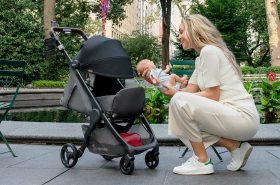Lifting your baby out of a cot, carrying a car seat (wow those things are heavy), making coffee one-handed with your little one on your hip: being a mum places serious demands on your body. While the early days and weeks post-birth should be focused on restoring your core and pelvic floor muscles (think of it like building a house: the core and pelvic floor are the foundations) after your 6-week GP sign off (or around 10-12 weeks if you had a C-section) it’s a great idea to start working on functional movement patterns that will get you stronger, make daily #mumlife tasks a little easier and even alleviate those newfound aches and pains.

By functional movement patterns, we mean exercises that mimic the things you do in everyday life. Getting up and down from the sofa is essentially a squat. Lifting your baby above your head? You’ve just done a shoulder press. Basically, functional fitness is opposite of the bells and whistles exercises you often see all over Instagram. While balancing one-legged on a Bosu ball with a Kettlebell in one hand might rack up the likes, it doesn’t exactly cross over into the movements you perform daily, whether that’s bending down to tidy up toys for the millionth time or going for a long walk with your baby in the carrier. Sure, squats and lunges may seem a bit, well, simple but there’s a reason that you’ll see them programmed in workouts like CARiFiT and PT session plans the world over: they work. And that’s not the only reason new mums should be doing them.
From a quicker recovery to reduced anxiety, increased energy levels to improved posture, the benefits of exercise after having a baby are plentiful, but – and this is something we’re evangelical about at CARiFiT – the movements you do need to be specific to your postnatal body. Your goal should be to create a base of strength that you can then build on; whether that’s a return to the exercise class you loved pre-baby or trying out some more challenging variations on the classics. To get you started, we’ve rounded up the five moves all new mums should master. You’ll recognise most of them from CARiFiT – the average session racks up a whopping 200 – 400 squats and a similar amount of lunges – while the core exercise is a key move in our CARiFiT 4 All core zone. Focus on nailing the correct form first – perform an exercise with poor technique and not only are you unlikely to recruit the intended muscles (making your workout a waste of time) you’ll fatigue faster and put yourself at risk of injury. Ready to get strong? Read on…
*Aim to do 8-10 reps of each exercise, 3 times. Combine the exercises together for a full-body circuit.
1. SQUAT – Muscles worked: Quads, hamstrings, glutes, core
Postnatal benefits: During pregnancy, your growing bump pulls the body into anterior pelvic tilt, creating short stiff hip flexors and lengthening and weakening your hamstrings and glutes. Basically, your posterior chain (muscles on the back of your body) switches off. As well as getting your glutes and hamstrings firing again, squats aid pelvis mobility, restore core stability and recruit the abdominal and pelvic floor muscles as you inhale to lower and exhale up.
How to:
-
Stand up straight with your feet shoulder-width apart, feet slightly turned out.
-
Inhale as you push your hips back and lower your bum down, shifting your weight into your heels. Keep your chest up and allow a slight curve in your lower back.
-
Lower until your thighs are parallel to the floor and your knees are in line with your second toe.
-
Drive through your heels and exhale as you return to standing, squeezing your glutes at the top.
Regressions/Progressions: to make the exercise easier, perform a sit to stand – getting up from a chair or sofa in a squat position and lowering back down, or try a squat holding onto a chair or table for balance. To make it harder, slow down the tempo, lowering down for 2-3 counts before driving back up.
For a much more detailed explanation of the benefits for new mums of the squat visit this blog post on the CARiFiT website.
2. SHOULDER PRESS – Muscles worked: Shoulders, core, upper back, triceps
Postnatal benefits: From lifting and holding your little one and all their gear to putting the shopping away or storing luggage overhead on a plane or train, a strong upper body is essential for mums. Pressing overhead doesn’t just strengthen your shoulders, it works your core, activating the deep TVA muscles and pelvic floor – bonus!
How to:
-
Stand with your feet shoulder-width apart. Hold a dumbbell in each hand at chin height, with your palms facing forwards. Inhale.
-
Exhale and use your shoulders to press the weights straight up overhead.
-
With a controlled motion, return the dumbbells to the starting position.
Regressions/Progressions: Lighten the load by swapping weights for resistance bands, perform the shoulder press seated, or try a single arm press, lifting one dumbbell at a time. Ready to progress? Push overhead and then slowly lower the weights back down for 2-3 counts.

3. LUNGE – Muscles worked: Quads, glutes, core
Postnatal benefits: Like squats, lunges build strong legs and glutes, which can help to alleviate common postnatal complaints like back and knee pain. Lunges also ease with tight hip flexors, recruit your core for stability and control and challenge your balance. We’ve focused on reverse lunges here as they place less stress on your knee joints than forward lunges, which is particularly important while the joint-loosening hormone Relaxin is still present in your body.
How to:
-
Stand with your feet shoulder-width apart and take a long step back with your right foot, bending both knees so they are at a 90-degree angle parallel with the floor.
-
Exhale and push through your right heel to stand up and return to the starting position.
-
Change legs and repeat, alternating each rep.
Regressions/Progressions: If you’re still working on your balance, use a chair, table or bench for support as you step back, or perform the move in a static position, lunging up and down instead of stepping back each time. To make it harder, add weights or slow the tempo of the lowering phase.
4. BENT OVER ROW – Muscles worked: Upper and middle back, shoulders, core, arms
Postnatal benefits: Feeding, rocking, cuddling, changing – as a new mum it can feel like you’re forever in a hunched position, which, combined with weakened abdominals, is a fast track to back pain. Bent over rows work your back muscles and help to counteract that rolled forward position your shoulders often default to post-baby.
How to:
-
Stand with your feet about shoulder-width apart and knees soft. Hold a dumbbell in each hand, palms facing the body. Alternatively, stand with both feet on a resistance band, holding the ends of the band just under your knees.
-
Tip your torso forward to around a 45-degree angle, keeping your back straight.
-
Leading with your elbows, exhale and row the dumbbells or bands back, squeezing your shoulder blades. You want your back to drive the movement, not your arms.
-
Hold the contraction for a second before lowering back down and repeating.
Regressions/Progressions: Regress the exercise with a resistance band, perform a seated resistance band row or try a single arm row. Ready to progress? Just grab heavier weights.
5. DEADBUG – Muscles worked: Core
Postnatal benefits: Even if crunches were postnatal tummy-friendly (in case you weren’t sure, they’re not) there are far more effective ways to strengthen your core. The deadbug is a powerhouse move that recruits the whole core, from the deep TVA muscles to the obliques and pelvic floor, as well as the stabilizing muscles of the lower back. Performed correctly, it’s a tough one, so you might need to start with simpler variations to maximise the benefits.
How to:
-
Lie flat on your back with your arms held out in front of you pointing towards the ceiling. Bring your legs up so your knees are bent at 90 degrees.
-
Making sure your back is in contact with the floor, slowly lower your right arm and left leg at the same time, exhaling as you do so.
-
Keep lowering until your leg and arm are just above the floor, taking care not to arch your back. Inhale as you slowly return your leg and arm to the starting position.
-
Repeat on alternate sides. Be sure to keep the movement slow and controlled to really engage the core.
Regression: to strip the exercise right back, move only the arms. Alternate each arm as you continue to hold your legs bent at 90 degrees, exhaling as you lower. Next, focus on legs only. Keep the arms straight up above your chest and exhale as you slowly extended one leg at a time.
Try a dudbug by following this video.
All of the moves described in this blog form key parts of the CARiFiT program. You can get your own home workout program started and learn more about the support and guidance on offer in our CARiFiT online membership HERE
CARiFiT online membership combines medical, physio and fitness information and workouts to support new mums back to full fitness and beyond, all whilst working out from home.




